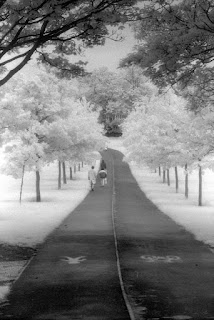StatCounter
Wednesday 27 July 2016
Saturday 9 July 2016
Tuesday 5 July 2016
So this is what it's all about, see the full article on Wikipedia, including how it applies to digital photography. More photos below.
In infrared photography, the film or image sensor used is sensitive to infrared light. The part of the spectrum used is referred to as near-infrared to distinguish it from far-infrared, which is the domain of thermal imaging. Wavelengths used for photography range from about 700 nm to about 900 nm. Film is usually sensitive to visible light too, so an infrared-passing filter is used; this lets infrared (IR) light pass through to the camera, but blocks all or most of the visible light spectrum (the filter thus looks black or deep red). ("Infrared filter" may refer either to this type of filter or to one that blocks infrared but passes other wavelengths.)
When these filters are used together with infrared-sensitive film or sensors, "in-camera effects" can be obtained; false-color or black-and-white images with a dreamlike or sometimes lurid appearance known as the "Wood Effect," an effect mainly caused by foliage (such as tree leaves and grass) strongly reflecting in the same way visible light is reflected from snow.[1] There is a small contribution from chlorophyll fluorescence, but this is marginal and is not the real cause of the brightness seen in infrared photographs. The effect is named after the infrared photography pioneer Robert W. Wood, and not after the material wood, which does not strongly reflect infrared.
The other attributes of infrared photographs include very dark skies and penetration of atmospheric haze, caused by reduced Rayleigh scattering and Mie scattering, respectively, compared to visible light. The dark skies, in turn, result in less infrared light in shadows and dark reflections of those skies from water, and clouds will stand out strongly. These wavelengths also penetrate a few millimeters into skin and give a milky look to portraits, although eyes often look black.
All these photos were taken on this Canon Powershot SX710HS with a visually opaque Wratten 87 (ish) filter. The filter was held in front of the lens. If not flush, light and reflections creep in as is apparent on some photos.
The most popular of the mono Infra Red films (Back in the day ---)
was "Kodak High Speed Infra Red" These two from 1990 ish
Which of course produced BW images. One of the great joys of Digital IR is that it produces colour images, These can be converted to pure BW, or manipulated for false colour.
Here's a couple of the recent batch, starting as the files appear copied from the camera, then a bit of manipulation, then BW.
Subscribe to:
Posts (Atom)




























































